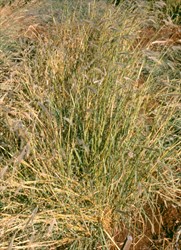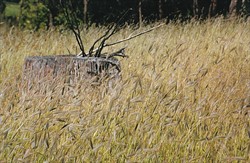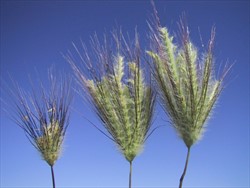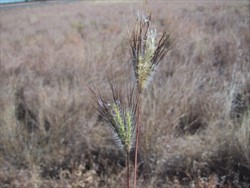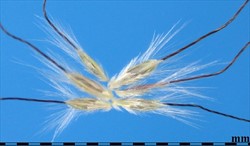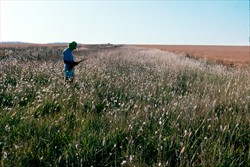Dichanthium sericeum
Tropical Forages
Dichanthium sericeum (R. Br.) A. Camus
Subordinate taxa:
Dichanthium sericeum (R. Br.) A. Camus subsp. sericeum
Dichanthium sericeum (R. Br.) A. Camus subsp. humilius (J.M. Black) B.K. Simon
Dichanthium sericeum (R. Br.) A. Camus subsp. polystachyum (Benth.) B.K. Simon
Dichanthium sericeum (R. Br.) A. Camus: Andropogon affinis R. Br.; Dichanthium affine (R. Br.) A. Camus
subsp. sericeum: Basionym: Andropogon sericeus R. Br.
subsp. humilius: Basionym: Dichanthium humilius J.M. Black
subsp. polystachyum: Basionym: Andropogon sericeus var. polystachyus Benth.; Andropogon superciliatus Hack.; Andropogon tenuiculus Steud.; Dichanthium superciliatum (Hack.) A. Camus; Dichanthium tenuiculum (Steud.) S.T. Blake
Family: Poaceae (alt. Gramineae) subfamily: Panicoideae tribe: Andropogoneae subtribe: Anthristiriinae.
Erect, often glaucous, annual or perennial, 30–80 (–120) cm tall; tufts mostly 10–15 cm diameter, generally rather slender, with a fairly weak root system. Culms densely branched at the base and often from the upper nodes; stems smooth, glabrous, except for a ring of erect white hairs 1.5–3 mm long on the nodes. Leaf blades flat, 8–15 cm long (–27 cm in ssp. polystachyum), 2–4 mm wide (–5.5 mm in ssp. polystachyum), green to grey-green or bluish-purple, typically glabrous sometimes sprinkled with tubercle-based hairs; ligules membranous, 0.5–1 mm long (–5 mm in ssp. polystachyum), ragged. Inflorescence a digitate panicle comprising (1–) 2–6 (–25 in ssp. polystachyum). Racemes sessile, erect, (2–) 4–8 cm long; rachis fragile at the nodes; spikelets paired crowded into 2 ranks; upper pairs, with a fertile sessile spikelet and a sterile pedicellate one, all densely hairy, giving a silky-hairy appearance to the inflorescence; lemma of upper sterile floret with brown, twisted hydroscopic awn 23–33 mm long. Caryopsis brown, 1–2 (–3) mm long, 1 mm wide.
Subspecies key
1. Lower glume of pedicelled spikelet obovate with sub-apical arch conspicuous, cilia erect from surface; robust annual.......subsp. polystachyum
1. Lower glume of pedicelled spikelet linear to narrowly ovate, cilia not erect from surface; annuals or perennials...................2
2. Spikelets c. 4.5 mm long and 1–1.4 mm wide; lower glume 9- or 10-nerved; racemes usually >4 cm long; perennial........subsp. sericeum
2. Spikelets to 4 mm long and 1 mm wide; lower glume 5–7-nerved; racemes <4 cm long; annual.................subsp. humilius
English: subsp. sericeum - Queensland Blue grass, silky bluegrass
subsp. humilius - annual bluegrass, slender bluegrass
subsp. polystachyum - tassel bluegrass
subsp. sericeum
Native:
Papuasia: Papua New Guinea
Australasia: Australia (New South Wales, Queensland, South Australia, Tasmania, Victoria, Western Australia, Northern Territory)
subsp. humilius
Native:
Australasia: Australia (New South Wales, Queensland, South Australia, Western Australia, Northern Territory)
subsp. polystachyum
Native:
Malesia: Philippines
Papuasia: Papua New Guinea
Australasia: Australia (Queensland, Western Australia, Northern Territory)
Naturalized:
Northern America: USA (Texas, Arizona)
Forage
Good quality natural grazing on heavier and more fertile black soils. Many of these soils in Queensland are also suitable for cropping and native pastures of D. sericeum remain only on non-arable landscapes and on lightly grazed pastures such as on roadsides. Makes good quality hay if cut before maturity.
Environment
D. sericeum is sometimes sown into "worn out" cropping land with the aim of bringing such areas back into useful pasture.
Soil requirements
Grows best on fertile, heavy black clays (vertisols) of neutral to alkaline pH. Ssp. polystachyum is more common on the lower fertility black soils of the monsoonal regions of northern Australia.
Moisture
The perennial ssp. sericeum is found over a wider rainfall range (300‒ >2,000 mm) than the two annual subspecies. The main area of D. sericeum distribution is the the 500–700 mm rainfall zone of the bluegrass downs of Australia. Tolerates saturated clays; ssp. polystachyum tolerates poorer seasonal waterlogging. All subspecies have reasonable drought tolerance but less so than the often sympatric species, Mitchell grass (Astrebla spp.).
Temperature
Summer growing but also reasonable growth in the cooler conditions of spring and autumn if moisture is available. Frost tolerance claimed as moderate to poor. Ssp. sericeum has been recorded from the tropics at 16° S to temperate zone at 43° S; ssp. humilius extends from about 18° S to 35° S; and ssp. polystachyum from 12° S to 26° S. It has naturalized in the Corpus Christi area (28° N) in S Texas, and been found near Tucson, Arizona (32°N) in southern USA.
Light
A species primarily of open grassland, it is intolerant of shade.
Reproductive development
Probably short-day response as it flowers February to May in Queensland, and November to April in South Australia.
Defoliation
Tolerant of moderate grazing. However, cattle and sheep, and especially horses, can pull plants out by the roots particularly during dry conditions, allowing less palatable grasses to increase.
Fire
Tolerates moderate intensity fires and recovers from seed buried in soil.
Guidelines for establishment and management of sown forages.
Establishment
The natural areas of Queensland bluegrass are self-regenerating, establishing very readily from seed. However, it can be slow to bulk up naturally on abandoned run-down cropping lands due to competition from annual grasses and broadleaf weeds and lack of soil seed supply. Not all seed will establish immediately when wetted which prevents loss of soil seed reserves, while partially germinated seed can return to dormancy (hydropedesis) when exposed to moisture stress during germination. These seeds will survive and resume germination when moisture becomes available. Where commercial seed is available, it can be difficult to spread because the fluffy awned seed does not flow through conventional machinery. De-awning and/or pelleting may improve flow.
Fertilizer
Generally low requirement for plant nutrients with production usually limited by moisture stress. Suitable basaltic soils rarely need additional phosphorus but some nitrogen could be beneficial when renovating run-down cropping land. Sulphur may be deficient on some basaltic soils.
Compatibility (with other species)
Associated with a range of native species on the bluegrass downs of eastern Australia including species of Bothriochloa, Panicum, Digitaria and Chloris and temperate grasses such as Stipa and Danthonia in the southern downs and with Eulalia and Iseilema spp. in the northern monsoonal regions. May be difficult to maintain with other more vigorous introduced species because it is highly palatable and preferentially grazed.
Companion species
Legumes: Annual medics (Medicago truncatula, M. polymorpha) in regions with sufficient winter rainfall. Often found with native legumes such as Rhynchosia minima.
Pests and diseases
Eaten by larvae of the dingy bush-brown butterfly (Mycalesis perseus Nymphalidae) and other insects.
Ability to spread
Spreads through wind disposal of fluffy seed and on animal coats and in mud on hoofs. D. sericeum rapidly recruits new seedlings given open space and warm moist conditions. Individual plants of ssp. sericeum live for about 3–4 years under moderate grazing.
Weed potential
Althugh listed in the Invasive Plants Atlas of the United States and Texas Invasives Database, it generally poses little threat outside its own area of endemicity.
Nutritive value
Good quality feed with up to 10% CP, 0.2% P and 62% digestibility. Quality drops quickly after maturity (10% CP drops to 4–6%) to become very low (2%) during the winter dry season.
Palatability/acceptability
Very palatable while green, and slender stems are more digestible than coarser grasses when pastures are mature.
Toxicity
None reported.
Feedipedia link
April 2020: Page under construction
Dry matter
Yields are dependent on soils and climate and because of its distribution range (see “Distribution” above), can vary from 1.5 to 9.0 t/ha.
Animal production
The carrying capacity of D. sericeum pastures is about one beast on 5 ha in the 600–700 mm rainfall areas of the Darling Downs of southern Queensland, Australia. Higher grazing pressure results in the loss of bluegrass.
2n = 20. Sexually reproducing diploids, possibly changing from apomictic to sexual reproduction as temperatures and photoperiod change in late summer.
Heavy seeding species that can be harvested using commercial brush harvesters. Seed yield 50–100 kg/ha. Seed shows post-harvest dormancy but with maximum germination within 12 months. Harvesting period can occur after first summer rains through to March (NSW) and May (Qld), with peak production generally in February and March (depending upon seasonal rainfall). Under dry conditions seed can drop rapidly, reducing the window of opportunity in which harvesting can take place.
Methods
Brush harvesting is the most successful, as the inflorescence ripens indeterminately. The action of the brush harvester only removes the ripened florets, allowing for more than one harvest of a crop.
Tolerant of atrazine.
- High quality grass.
- Palatable.
- Drought tolerant.
- Early spring growth.
- Limited to fertile heavier soils.
- Declines under heavy grazing.
Burrows, W.H., Scanlan, J.C. and Rutherford, M.T. (1988) Native pastures in Queensland: The resources and their management. Department of Primary Industries, Brisbane, Queensland, Australia.
Jacobsen C.N. (1981) A review of the species of Dichanthium native to Australia with special reference to their occurrence in Queensland. Tropical Grasslands 15:84–95. bit.ly/2xrJJOO
Milson, J.M. (2000) Pasture plants of north-west Queensland. Information Series QI00015. Queensland Department of Primary Industries, Brisbane, Australia.
Tothill, J.C. and Gillies, C. (1992) The pasture lands of northern Australia: Their condition, productivity and sustainability. Occasional Publication No. 5. Tropical Grassland Society of Australia, Brisbane, Australia. hdl.handle.net/102.100.100/246791
Tothill, J.C. and Hacker, J.B. (1983) The Grasses of Southern Queensland. Tropical Grassland Society of Australia, Brisbane, Australia.
‘Scatta’ Released in Australia (2006).
None reported.
